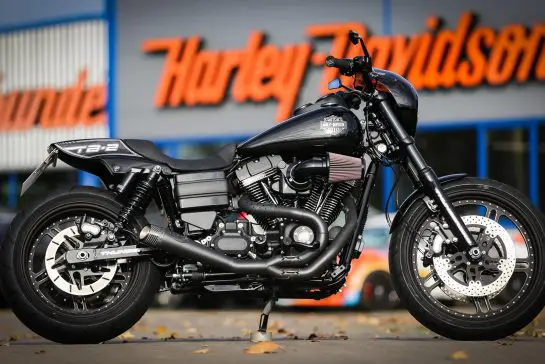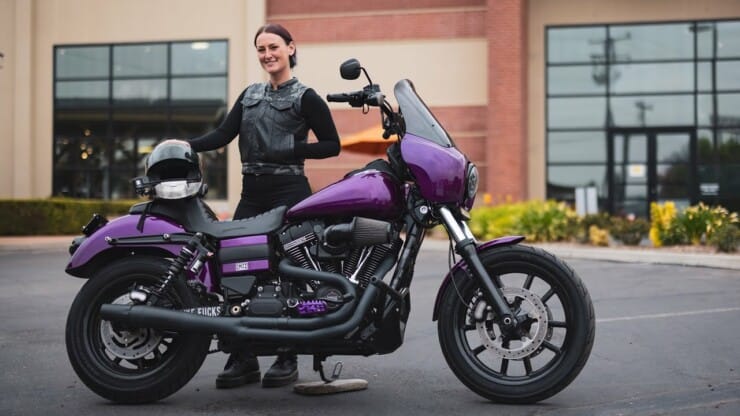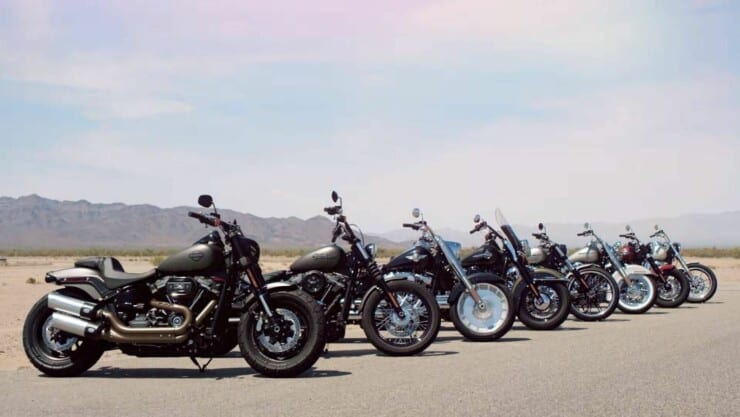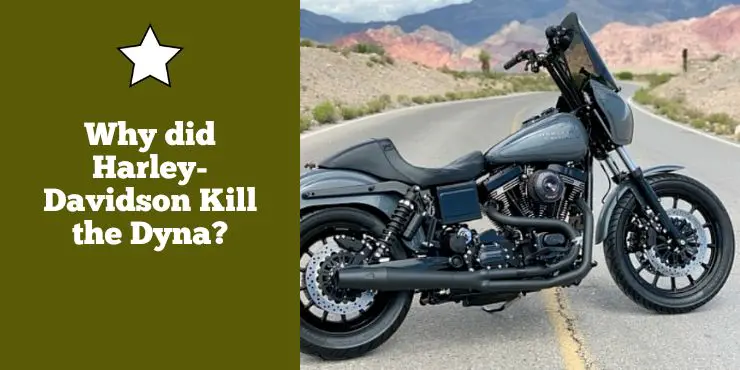The Harley-Davidson Dyna has been a staple of the Harley-Davidson lineup for over two decades. But, after all of this time, why did Harley-Davidson choose to discontinue the Dyna?
Harley-Davidson discontinued the Dyna line in 2018, merging it with the Softail lineup to create a single platform with improved handling, frame rigidity, and updated suspension while keeping classic styling.
In this article, we’ll explore the reasons behind the discontinuation of this beloved motorcycle and examine the impact it has had on the Harley-Davidson brand. So, if you want to know why Harley-Davidson chose to say goodbye to the Dyna, keep reading!
Overview of the Harley-Davidson Dyna
Harley-Davidson is a name that has long been synonymous with American motorcycle culture. The brand has been building bikes for almost 120 years, and it is known for its iconic branding, classic styling, and powerful engines. One of the most popular bikes in the Harley-Davidson lineup is… or was… the Dyna lineup.
The Harley-Davidson Dyna was introduced back in 1991 as a replacement for the FXR model. It quickly ended up becoming an incredibly popular option with riders looking for a powerful, versatile motorcycle that could handle a wide variety of riding styles and terrains. Today, the remaining second-hand Dyna models are still a popular option for riders who are looking for a high-performance machine that can take them on long-distance drives or handle the twists and turns of city streets.

History of Harley-Davidson Dyna
As mentioned above, the Harley-Davidson Dyna was officially released in 1991 with the FXDB Sturgis model and named after the famous Sturgis Motorcycle Rally in South Dakota. The FXDB Sturgis was a limited edition motorcycle that featured a unique black and silver paint scheme and a nostalgic style, paying homage to the early Harley-Davidson bikes.
The Sturgis model was quickly followed by the FXD Super Glide in 1995, which became one of the most popular models in the Dyna lineup within no time. The Super Glide featured a low-slung design with a wide front end and a skinny rear tire, which gave it a sleek and aggressive look. It came powered by Harley-Davidson’s venerable Evolution engine, which had been in production since 1984.
Over the years, the Dyna lineup continued to evolve and expand, with new models getting introduced and existing models getting updated with new features and technology. In 2006, the Dyna received a major redesign, with a brand-new frame and suspension system that improved handling and ride quality.
One of the most popular models in the Dyna lineup was the FXDL Low Rider, which was introduced in 1993. The Low Rider was a classic Harley cruiser with a low-slung profile, swept-back handlebars, and a comfortable riding position. It came powered by a 1,340cc Evolution engine and featured a five-speed transmission.
In 2008, Harley-Davidson introduced the Dyna Fat Bob, which was designed for appealing to a younger and more aggressive audience. The Fat Bob featured a wide front end, a powerful Twin Cam engine, and a beefy rear fire. It quickly ended up becoming one of the most popular models in the Dyna lineup.
In 2017, Harley-Davidson announced its decision to discontinue the Dyna lineup and replaced it with a new lineup of bikes called the Softail. The Softail featured a new frame and suspension system, combined with the classic look of a Harley-Davidson Cruiser with modern technology and performance. Despite the discontinuation of the Dyna lineup, these bikes continue to hold a special place in the hearts of Harley-Davidson enthusiasts all over the world. With their powerful engines, classic styling, and unmatched performance, the Dyna will always be fondly remembered as one of the most beloved series of bikes in Harley-Davidson’s rich history.
Reasons why did Harley kill the Dyna
Harley-Davidson Dyna was a popular line of bikes that were known for their incredible power, performance, and stylish design. However, in 2017, the brand made a shocking announcement that it would be killing off the Dyna line. This move was met with rather mixed reactions from the motorcycle community. Some of them praised the decision, while others were more than disappointed to see the iconic line come to an end. But why did Harley kill the Dyna line? Here are some of the reasons why Harley-Davidson decided to kill the Dyna line and replace it with the Softail line –
#1. Declining sales
There were several factors that contributed to Harley-Davidson’s decision to discontinue the Dyna. One of the primary reasons for this decision was due to the declining sale. Recently, the motorcycle industry as a whole has been experiencing a decline in sales, and Harley-Davidson is no exception. Despite being a rather popular model for many years, the sales of the Harley-Davidson Dyna had been declining for some time. This was due to the changes in the motorcycle market and a shift toward more adventure and touring bikes, as well as increased competition from other brands.
Harley had been struggling to attract young riders, and the Dyna line was seen as an outdated and less appealing option to the younger demographic. By killing off the Dyna line, Harley-Davidson was able to focus more on developing newer and more modern bikes capable of attracting younger bikers.
#2. High production costs
Another major reason for Harley-Davidson’s decision to kill the Dyna line was due to high production costs. The Dyna was a complex bike to manufacture, with various distinct features that made it stand out from other Harley-Davidson motorcycles. However, the unique features came at a price, and the production costs of the Dyna were much higher than other models in the Harley-Davidson lineup.
With the Dyna being a more expensive model to produce compared to other Harley-Davidson bikes, the company had to streamline its operations to be competitive. As a result, the Dyna line was no longer financially viable for the company. This is why Harley needed to cut costs to remain competitive in an extremely challenging market, and the high production costs of the Dyna were way too much to bear.
#3. Poor performance
Poor performance was another major contributing factor to the discontinuation of the Dyna line. Despite the model having a loyal following, there are many complaints about its handling and suspension, which affected its overall performance. The company recognized the need to improve the performance of the Dyna to keep up with the evolving motorcycle market, and the cost was too much to handle.
#4. Overcrowded model lineup
Another reason for Harley-Davidson discontinuing the Dyna line was the overcrowded model lineup and the need to streamline its offerings. The company had numerous different lines of motorcycles, and some of the officials felt that it was creating confusion among consumers. With Harley-Davidson selling a wide range of models like the Softail, Sportster, and Touring lines among others, Dyna overcrowded the lineup.
The company recognized that it had to simplify its offerings to reduce complexity and make it easier for its customers to understand the options available. By killing the Dyna line, Harley was able to achieve just that.
Despite the end of the Dyna line, Harley-Davidson still continues to be an extremely dominant force in the motorcycle industry. While the decision to discontinue the Dyna line might have been a difficult one, it ultimately proved to be the right decision for the company, as it was able to continue improving the performance and design of its remaining models and meet the changing needs and preferences of its customers.
The brand’s dedication to producing high-quality machines that cater to the need of bikers worldwide make it a beloved brand that riders can trust. Harley-Davidson remains committed to offering bikers an exceptional riding experience and while the Dyna might be gone, the company’s passion for bikes continues to live on.

Alternate routes Harley could have taken instead of discontinuing the Dyna line
Harley-Davidson’s decision to kill the Dyna line was a shocking and significant blow to Harley enthusiasts around the world. The Dyna was an incredibly popular bike during its nearly 25-year history. However, declining sales, high production costs, dwindling popularity, and more were some of the factors that led to its discontinuation. However, some claim that there were alternative routes that could have been pursued by Harley-Davidson instead of killing the Dyna. Here are some of the alternative solutions –
#1. Modifications to the Dyna
One of the solutions Harley-Davidson could have taken is to make certain modifications to the Dyna models. These modifications could have made the bikes more appealing to customers. The manufacturers could have also included changes to the design, engine, and other features that could have improved Dyna’s performance and made it more competitive in the market.
Harley-Davidson could have also invested in research and development for creating a next-generation Dyna that addressed the concerns of customers and improved upon the existing model. Further, the manufacturers could have also tried making modifications by developing more advanced engine technologies and making improvements to the suspension and brakes for enhancing the riding experience. This approach could have allowed Harley-Davidson to keep the Dyna in its lineup while still keeping up with the evolving demands of modern riders.
#2. Redirecting resources
Another alternative solution that Harley-Davidson could have explored was redirecting resources from other parts of its company toward the production of the Dyna. For instance, Harley-Davidson could have reduced its focus on other models and invested more resources in the Dyna line instead.
This would have involved cutting back on the production of other models to focus more on the Dyna, which would have helped reduce the production costs and improve the overall quality of the bike. By reallocating resources to the Dyna, Harley-Davidson could have made further advancements to the bike and made it more competitive without needing to discontinue it.
#3. Rebranding the Dyna
Harley-Davidson could have considered rebranding the Dyna as a different type of motorcycle. By changing the name and marketing it as a new mode, Harley-Davidson could have given the bike a fresh start. Further, Harley could have generated renewed interest in the bike and attracted new customers who may have been put off by the previous branding.
This could have involved updating the Dyna’s design, engine, or other features to appeal to a newer generation of riders. By rebranding the bike, Harley-Davidson could have breathed new life into the Dyna line and kept it in their lineup while still maintaining the heritage and legacy of the brand.
#4. Creating a new model
Harley-Davidson’s decision to discontinue the Dyna line of motorcycles was a significant one, and it ultimately led to many bikers feeling disappointed. However, Harley-Davidson could have created an entirely new model that incorporated some of the key features of the Dyna while addressing some of the issues that led to the line’s ultimate discontinuation. This would have allowed the motorcycle company to keep up with changing rider demands while still maintaining a strong brand identity.
Impact of killing the Dyna
Harley-Davidson’s decision to kill the Dyna model line was a shocking and significant move that had major implications in more ways than one. This move had significant ramifications on the company’s revenue, customer satisfaction, and other model lines, and even its competitors. The move caused a lot of controversy among Harley-Davidson enthusiasts, as the Dyna model was one of the most popular and iconic bikes.
The Dyna was known for its classic style and powerful. However, this decision was made in an effort to streamline the brand’s lineup and focus on more profitable models, but the impact of killing the Dyna was significant.
#1. Revenue loss
One of the most significant impacts of the decision to kill the Dyna line was the loss of revenue for Harley-Davidson. In its nearly 25-year long run, the Dyna line was a popular model line and one of the bestselling models and generated significant sales for the company. Further, it had many loyal customers who were disappointed to see it go. By killing the Dyna line, Harley-Davidson likely experienced a dip in its revenue in the short term.
Additionally, the company lost the potential for future revenue from customers who would have chosen a Dyna model in the future. While the company hoped to offset this loss by putting more focus on other models, the discontinuation of the Harley-Davidson Dyna had a negative impact on its overall sales.
#2. Customer satisfaction
Another significant impact of killing the Harley-Davidson Dyna was the effect this decision had on customer satisfaction. The model was a particular favorite among many Harley-Davidson enthusiasts, and killing it meant that the customers were left disappointed. Further, the customers who were loyal to the Dyna felt betrayed by the company’s decision to discontinue it.
Many Harley enthusiasts felt that the company was abandoning a model with a rich history that had been a staple of the brand for years. This led to a loss of trust in the company, as many customers started to question whether Harley-Davidson truly valued their opinions and loyalty. The dissatisfaction potentially led to a loss of brand loyalty as well as a decline in sales.
#3. Effects on other models
The discontinuation of the Harley-Davidson Dyna also had a significant impact on other lines and other models of Harley-Davidson. The Harley-Davidson Dyna was often used as a gateway motorcycle for beginners and novices, and its absence in the Harley lineup made it much harder for customers to transition to other models. Moreover, the loss of the Harley-Davidson Dyna’s unique features like a supreme engine, classic styling, and dual-shock rear suspension left a gap in the lineup that was rather difficult to fill with other models.
With the Dyna gone, the customers who were interested in this style of bike chose to turn to other brands or models within the Harley-Davidson lineup. The shift could have had a ripple effect on Harley’s other model lines and potentially impacted their sales.
#4. Effects on competitors
Lastly, the decision to kill the Harley-Davidson Dyna also had an impact on the company’s competitors. The company’s decision might have given competitors an advantage in the market. As the customers were disappointed with the lack of a Dyna model from Harley-Davidson, they ultimately turned to other brands that offered similar bikes. Moreover, many other motorcycle manufacturers saw this as an opportunity to capture the market share that Harley-Davidson was losing. Some of the competitors also started to develop bikes that were similar in style and performance to the Dyna, further eroding Harley’s market dominance.

Other options to go for after the discontinuation of the Dyna line
Harley-Davidson’s decision to discontinue its Dyna model was sudden and left many bikers disappointed. Although it is almost impossible to fill the void left behind by Harley-Davidson, there are alternative Harley-Davidson models that you can choose for an almost similar experience. Here are some of the top choices for bikers looking to enjoy the Harley-Davidson experience after Harley discontinued Dyna –
#1. Harley-Davidson Softail
The Harley-Davidson Softail model offers an extremely comfortable ride with a classic look. It has a low-slung design and comes with a wide range of engine options, including the Milwaukee-Eight 107 and 114. The Softail had a modern suspension system capable of providing better handling and improved performance compared to the Dyna.
#2. Harley-Davidson Sportster
The Harley-Davidson Sportster is a popular choice for bikers who want a Harley with a smaller engine. It comes with a 1200cc engine and offers a nimble ride with a classic look. The Harley-Davidson Sportster is more affordable than some of the other models.
#3. Harley-Davidson Touring
The Touring model is perfect for bikers who love to go on long-distance rides on highways and open roads. It comes with a range of engine options, including the Milwaukee-Eight 107 and 114. The Touring also comes with a comfortable riding position and offers a smooth ride thanks to the advanced suspension system.
#4. Harley-Davidson Street
The Harley-Davidson Street model is perfect for bikers who want a Harley with a more urban footing. It comes with a 750cc engine and offers tremendous handling and agility. The Street has a sleek design and is ideal for navigating busy city streets
#5. Harley-Davidson Fat Boy
The Harley-Davidson Fat Boy is a popular choice for bikers who are looking for a Harley with a modern look. It comes with a powerful 114ci engine as well as advanced features like LED lighting and a digital gauge. The Fat Boy also has a unique style that sets it apart from other Harley models.
#6. Harley-Davidson Roadster
The Harley-Davidson Roadster is another impressive option for bikers who want a bike with a smaller engine. It comes with a 1200cc engine and has a stripped-down design that gives it a raw and edgy look. It is the perfect option for bikers who want a Harley-Davidson bike with a sporty feel.
FAQs
What was the reason for Harley-Davidson’s decision to discontinue the Dyna?
Harley-Davidson’s decision to discontinue the Dyna was based on their strategy to focus on the Touring and Softail models. As the company looked to build its portfolio of modern, high-performance motorcycles, they decided to phase out the Dyna and concentrate on the more popular Touring and Softail models.
What were the features of the Dyna model?
The Dyna model was a line of Harley-Davidson motorcycles that were known for their nimble handling and responsive performance. The Dyna was available with several engine sizes, ranging from the Twin Cam 88 to the Twin Cam 103, and included several models such as the Super Glide, Street Bob, and Wide Glide.
What are the alternatives to the Dyna?
Those looking for a similar riding experience to the Dyna can look to the Touring and Softail models. The Touring models offer a comfortable ride with a focus on long-distance cruising, while the Softail models offer a more responsive ride with greater agility. For those looking for a more classic Harley-Davidson ride, the Sportster line offers a similar feel to the Dyna.

